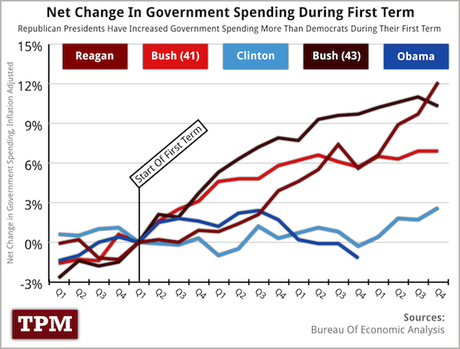 A few months ago, it appeared the economy was gaining steam and entering a so-called 'virtuous circle.' US employers added a robust 275,000 jobs in January. But then that number dipped to 259,000 in February, 154,000 in March, and a disappointing 115,000 in April. To put that in perspective, at least 88,000 jobs (a conservative estimate) must be added each month just to keep up with population growth. In one fell swoop, the recession gobbled up about 12 million jobs. And if Obama were to win a second term, the economy would have to add 291,000 jobs per month on average between now and the end of that term just to reach pre-recession levels of employment. If you'd like to crunch your own numbers, here's an interactive calculator.
A few months ago, it appeared the economy was gaining steam and entering a so-called 'virtuous circle.' US employers added a robust 275,000 jobs in January. But then that number dipped to 259,000 in February, 154,000 in March, and a disappointing 115,000 in April. To put that in perspective, at least 88,000 jobs (a conservative estimate) must be added each month just to keep up with population growth. In one fell swoop, the recession gobbled up about 12 million jobs. And if Obama were to win a second term, the economy would have to add 291,000 jobs per month on average between now and the end of that term just to reach pre-recession levels of employment. If you'd like to crunch your own numbers, here's an interactive calculator.Anyway, 115,000 is a downright pitiful number. It's not just a private sector problem. The public sector has slashed jobs at unprecedented rates, turning a 7.1% unemployment number into an 8.1% statistic. As you can see from the graph above, Obama is the only president of the last five to introduce austerity and cut spending during his first term. And at what a time - during the worst financial collapse since the Great Depression! That, coupled with substantial state and local government cuts, has deepened the recession. How bad it has gotten is astounding to contemplate. So many have given up looking for work that the labor force participation rate (63.6%) is the lowest in three decades. 200,000 will see their unemployment benefits expire this month. An all-time high 49.1 million Americans are living in poverty. Those who do attempt to use education as a ticket to a better life carry over $1 trillion in student loan debt, seriously limiting their economic prospects and risk-taking ability.
An economic crisis of this scope and duration begs action on a truly large scale. There are several palatable options. One might be ending all tax loopholes and subsidies, and mandating that the money saved be used on a FDR-style Works Progress Administration until unemployment dips to 6%. Another might be doubling, tripling, or even quadrupling the federal investment in infrastructure. There is a mind-bogglingly great amount of work to be done. Roads, bridges, and electrical grids need building and refurbishing. New high-speed rail lines would move people and goods more efficiently, reducing carbon emissions and improving bottom lines. Instituting nationwide access to high-speed internet would not only employ people directly, but also enable hundreds of small businesses to drive further job creation. Most important of all is renewable energy infrastructure, where we have untapped potential to become a world leader.
All these things should be on the table if we want to revitalize our economy. Most could enjoy a broad base of popular support. But none are politically feasible - largely because of small imaginations and an inactive Congress. I want to be optimistic about the future. But with this in mind, it's often only too hard.

